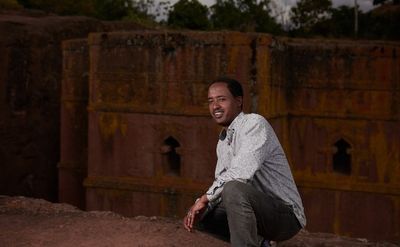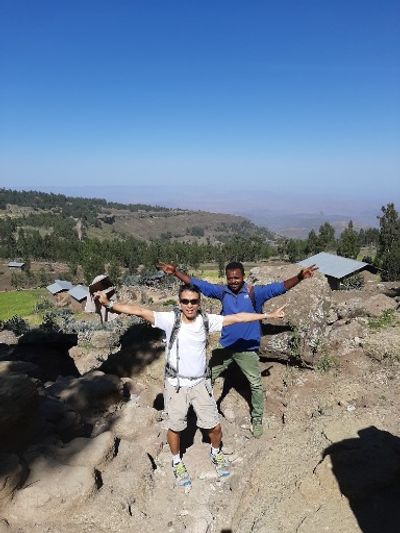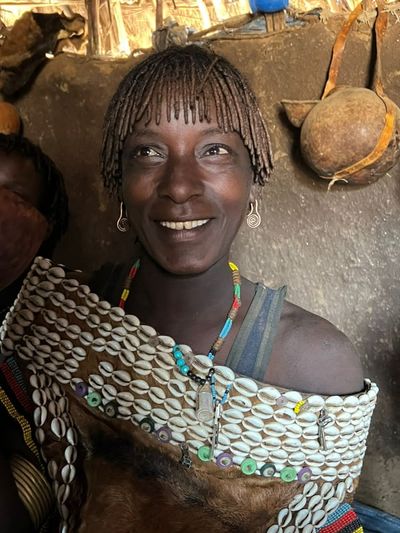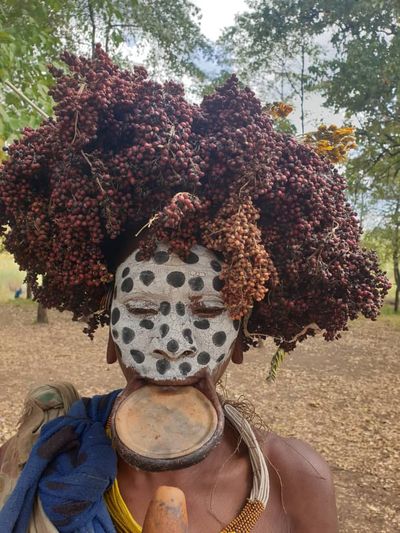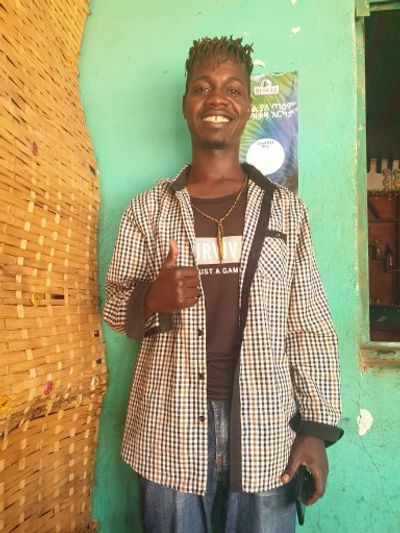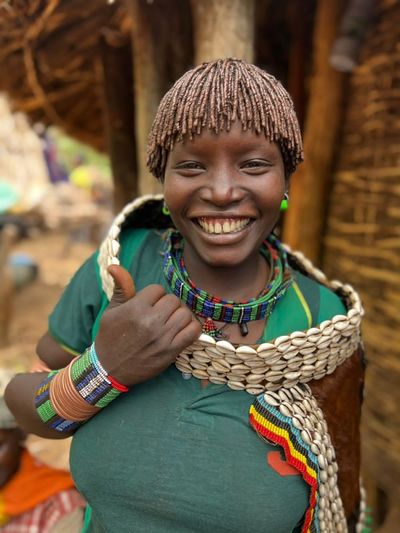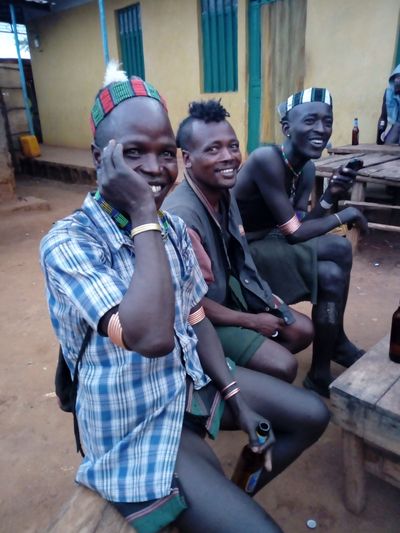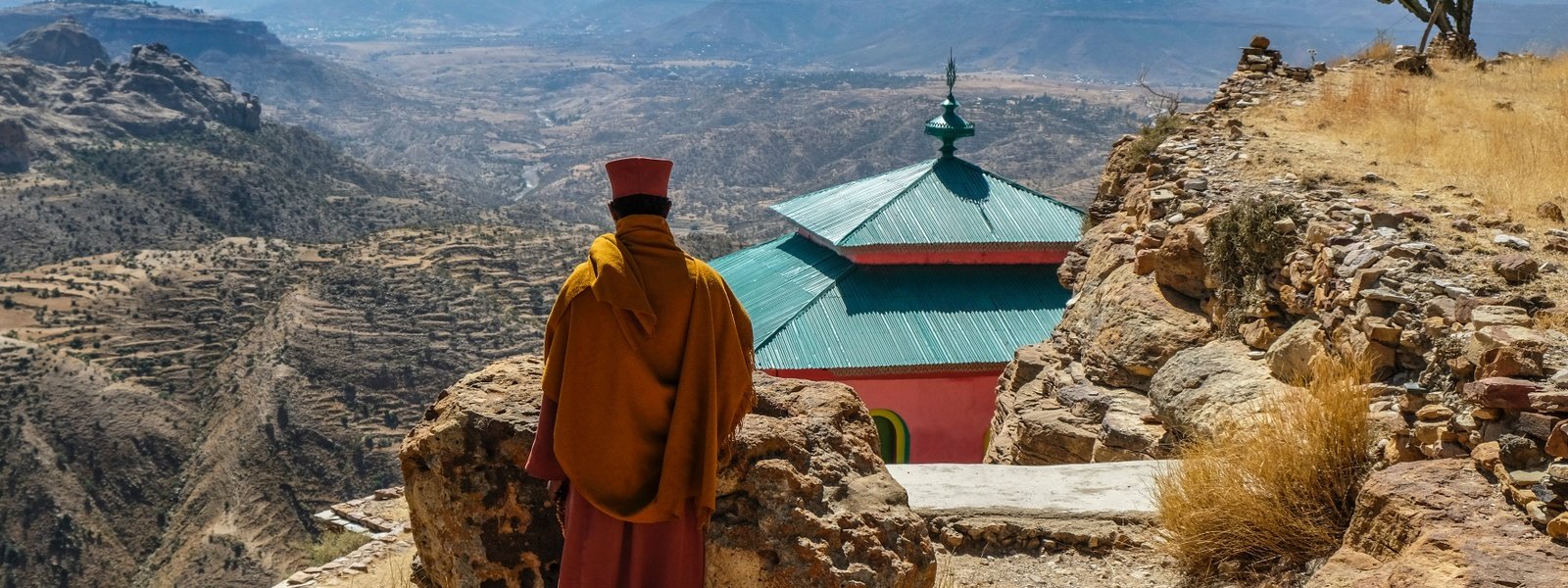
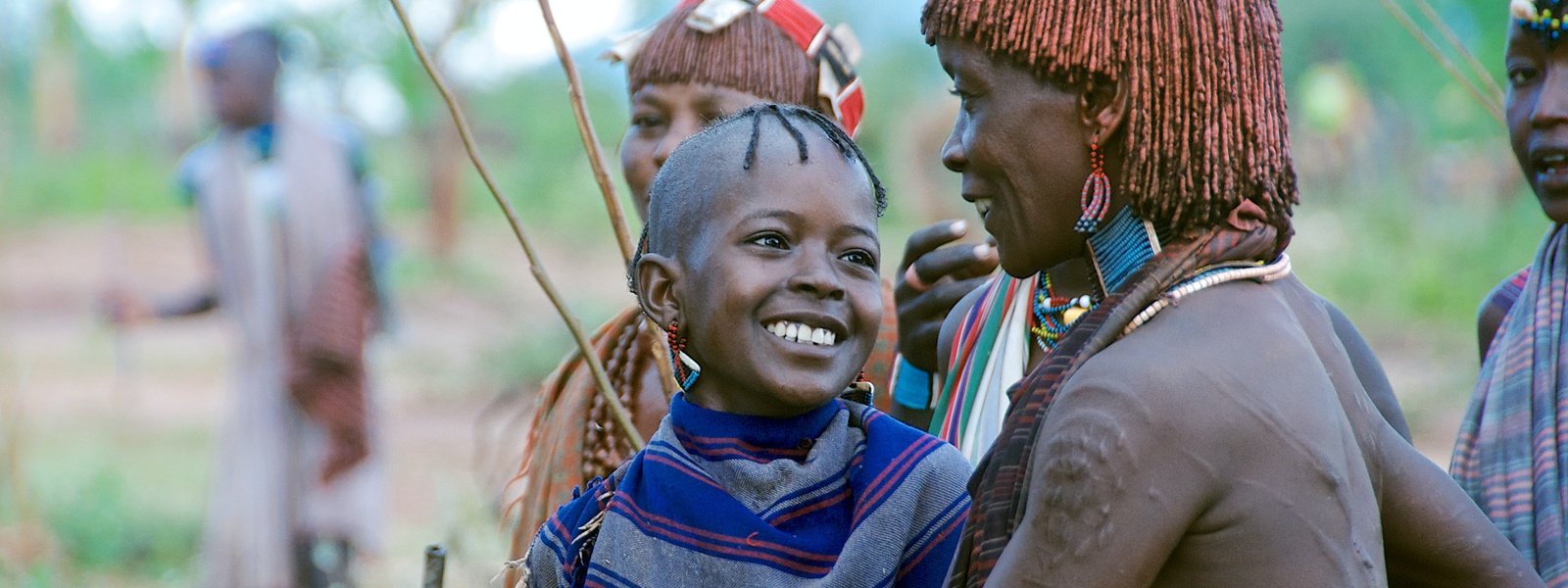
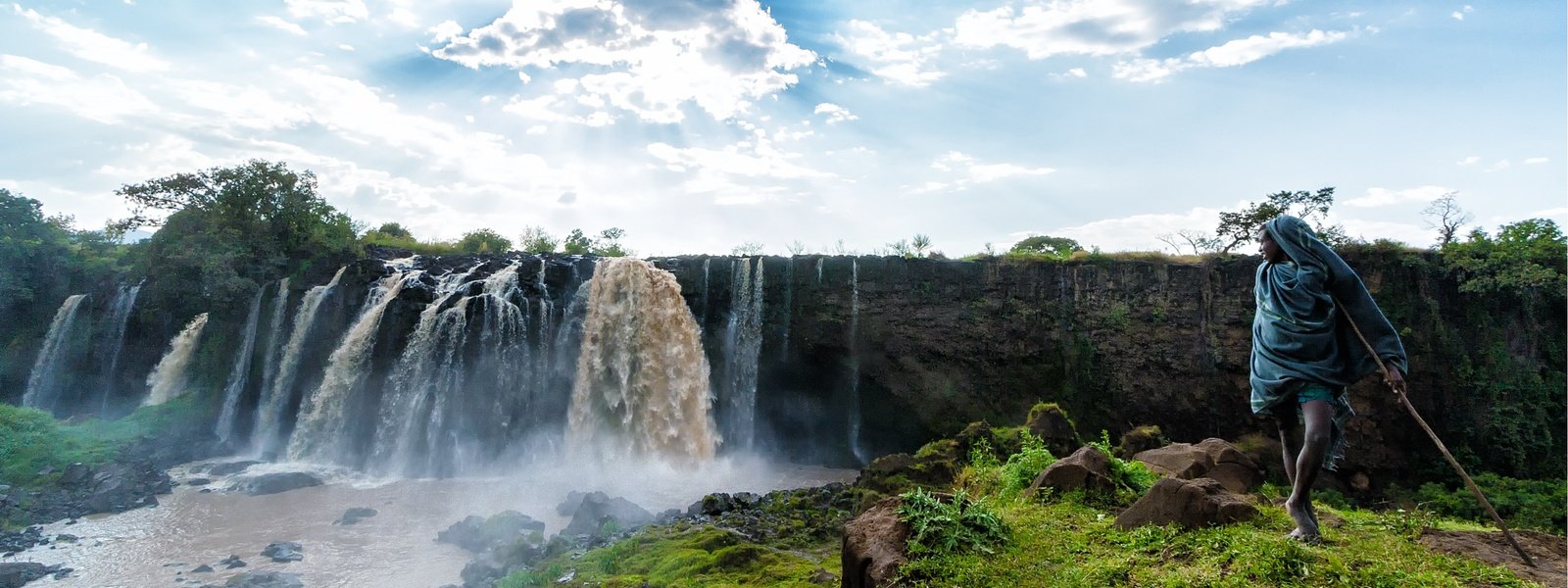
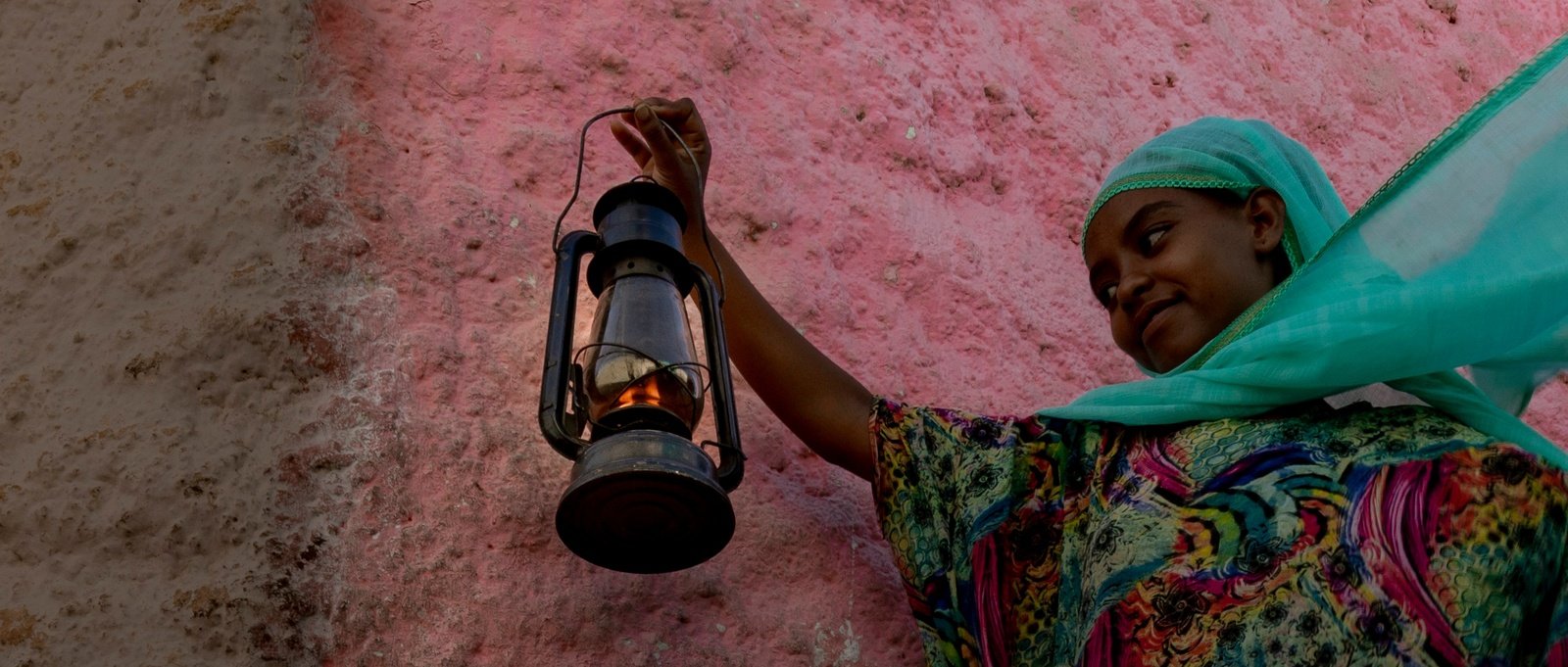
Ethiopia
Lower Omo Valley, Konzo and Dorze
Portrait of a Suri woman smoking her calabash pipe, Photograph: Trevor Cole/Unsplash
The Lower Omo Valley, Konzo, and Dorze are situated in the Southern Nations, Nationalities, and Peoples Region, which is a multinational state in Ethiopia. Even though the lives of the people, whose agro-pastoralist livelihood largely depends on the Omo-river, are threatened thanks to globalization, climate change, and large development projects such as a new dam building, the different ethnic groups living here still maintain their traditional lifestyle. This is why these areas are very attractive for travelers, where one can be amused by the distinct (from each other as well) traditions, culture, colorful clothing, and ceremonies of the different tribes. If you travel here with an open mind, you can gain a life-long experience and learn about how humans can live in different ways closer to nature.
Facepainting on a Hamer man, Photograph: Gianfranco Gori/WikiCommons
Visiting the Omo Valley responsibly
First of all, before getting into more details of what to do and see in the Omo Valley, Konzo and Dorze, it is essential to note that mass tourism in Omo Valley is getting more and more widespread, so when someone decides to visit the region, it is important to consider in advance how to travel here responsibly and more sustainably. This kind of “cultural tourism” can provide additional revenue sources for the locals and can broaden the travelers’ world view, however, it is inevitable to think about how not to exploit the culture of the local tribes and how not to treat people as an “attraction” or only as an object of a photo. Instead, one should go and visit Omo Valley with an open mind and consider how their visit can contribute to cultural and knowledge exchange, and how the people living in the area can actually benefit as well.
Portrait of a Hamer Woman, Photograph: Yi Wu/Unsplash
We have collected some general advice that you can follow if you decide to visit the region:
People in the area use face paintings, colorful jewelry, and clothes as a way of expressing themselves, so it is always tempting to take photos, however always ask permission beforehand, as you would normally do in your home country. People are generally fine with photos, but you have to respect if someone says no. It is often common in the case of some tribes, like the Mursi and Surma, who are going to ask for a small price in exchange for the photo, in order to generate some extra income.
Sometimes the traditions of the different tribes can seem a bit cruel or strange, but always remember that you are the visitor in the area. Arrive with an open mind and always show respect towards the locals, and be thankful that they welcomed you in their culture.
Finally, think about how you can contribute to the host communities, rather than treating the people as an “attraction” who provide a service for you. Always think about how your hosts can benefit from your visit as well.
Portrait of a Dassanech girl, Photograph: Fabio Mondelli/Pixabay
Tribes of Lower Omo Valley
The Lower Omo Valley is home to distinct ethnic groups, two national parks, the Mago and Omo National Park, and is recognized as a UNESCO World Heritage Site thanks to the discovery of many fossils there, that had great importance in the study of human evolution. Jinka is the main entry point for the area, and other bigger towns include Dimeka, Turmi, Key Afer, Omorate, that are great places to stay for the night in order to easier reach the villages of the different ethnic groups. Moreover these towns host (bi-)weekly colorful markets that also serve as a meeting point for the different tribes in order to socialize. We have listed some of the most visited tribes who welcome visitors as well with keeping in mind that this is not an extensive list of all the ethnic groups living in the region.
Hamer Women at Market Day in Dimeka, Photograph: Eszter Kisgyura/Localme
There are around 10,000 Mursi people living in the Lower Omo Valley, partly in the Mago National Park. They are the most photographed tribe in the area, thanks to their colorful clay lip plates or disks that women wear nowadays mainly as a sign of beauty. Traditionally they started to wear it to scare slave traders, or other hostile tribes away. The lip plates are part of a voluntary initiatory process into womanhood, however, nowadays more and more young girls decide not to wear them. The Mursi, similarly to other tribes, depend on the Omo River and agro-pastoralism, however, they engage in tourism more and more as an additional revenue source.
Portraits of people from the Mursi tribe, Photograph: Eszter Kisgyura/Localme
The Surma or Suri (a collective term for three ethnic groups in the region) are close relatives to the Mursi, whose women also wear lip plates. The men engage in the traditional stick fight, called the donga (a tradition at the Mursi tribe as well).
Surma men waiting for a donga (traditional stick fight) in Kibish village, Photograph: Trevor Cole/Unsplash
There are around 50,000 Hamar (or Hamer) people in the area. They are most well-known for their traditional ceremony of bull-jumping and their distinct style of clothing. The Bana, also numbering around 50,00 people are closely related to the Hamer, and sharing a very similar culture and traditions (like bull-jumping). The Hamar are more well-known, but it always depends on your guide's ethnicity, background, or networks which tribes you will engage with more, and the Banna people are very welcoming as well.
Young women from the Hamar tribe, Photograph: Fabio Mondelli/Pixabay
The Hamar women has a very distinct ochre-colored hairstyle hanging down in thick plates. They wear copper bracelets tightly around their arms and colorful beaded bands hanging from around their waist. The Banna women's hairstyle and clothing are similar to the Hamer, wearing leather dresses with colorful pearls, and especially younger people (both men and women) like mixing tradition with modernity for instance with colorful hair clips.
Portrait of Hamar woman, Photograph: Fabio Mondelli/Pixabay
Bull-jumping is the most important event in the Hamer and Banna society and is part of a three-day-long initiation rite. for the young men who are wishing to start living their life by marrying a woman and building up his and his family's own cattle herd. During the ceremony, the community gathers to celebrate together by drinking some sorghum beer. By jumping a row of bulls (around 10), the young man has to prove that he is strong and mature enough. If he does not succeed he can try next year. As part of the ceremony, the women get whipped by the young men before the bull-jumping in order to show their strength (someone from the Banna community told us that this prepares young women for the pain that happens during giving birth to a child). Getting whipped is voluntary, however, because it is part of the tradition, peer-pressure is very strong. It is understandable if this act seems cruel, but it is part of a tradition, and remember you are the visitor now.
A girl from the Hamar tribe in the Omo Valley responds to an elder tribeswoman, Photograph: Trevor Cole/Unsplash
The area of Omorate lies in a harsh environment, where heat can be quite unbearable as the temperature often rises above 40 Celsius degrees, however it is the perfect place to visit the Omo River. The main attraction is to cross the river with a small boat to visit the villages of the Dassanech tribe. The Dassanech migrated from Kenya to their current home, traditionally purely following a nomadic pastoralist lifestyle. Nowadays they also engage in fishing and agriculture, but their nomadic roots can be clearly seen for instance when looking at their huts which are similar to the homes of other desert pastoralists.
Dassanech pastoralists sitting in front of their huts, Photograph: Fabrizio Frigeni/Unsplash
Other tribes that can be interesting to visit are the Karo (or Kara), famous for their body and face paintings. They are decorating their body with locally found sources, such as white chalk, yellow mineral rock, and their most well-known designs ranging from simple and fine dots to rough lines on their faces. The Arbore people living at Lake Chew Bahir, well-known for their spectacular jewelry, the Tsemai are the least documented and visited tribe in the area, the Ari are famous for their pottery, the Nyangatom are the most feared warriors famous for their singing and storytelling, and the Bodi people, who have a strange tradition of drinking cow-milk for half a year in order to compete with each other in who can get the fattest.
Arbore Kid, Photograph: AnnaMaria Donnoli/WikiCommons
Dorze people
The Dorze is a small ethnic group living near Arba Minch, in the Southern Nations, Nationalities, and Peoples Region. It's a long drive uphill to reach the Dorze villages, that are located more than 2,000 metres above sea level. The main attraction here is the elephant huts that are constructed entirely from natural materials, like bamboo strips and the welcoming Dorze people who are happy to share their traditions with the travelers. It is not a coincidence that the huts look like elephants, as they were designed after them who were once freely roaming around the area. The locals are happy to show how to cook "false banana" pancakes and serve them with local honey and strong local spirit if someone is keen to try it!
Elephant huts from Dorze, Photograph: Richard Mortel/WikiCommons
One of the attractions in Dorze is the Masiqqala festival stretching through September. It is a traditional New Year celebration at the end of the crop cultivation season. Different cultural practices are happening throughout the month, such as the woman's day (sofe masiqqala) and the slaughtering day (shuhuaqamma), when around 700-1000 bulls are slaughtered on the local market (bodo). All the families from the community have to attend the shuhuaqamma, and after the slaughtering, everyone gathers together to eat raw meat with kocho (flatbread made from enset, the "false banana) and spices and drink local liquor like tej (honey-wine), and ending the day with a huge bonfire. When visiting this festival people greet each other with "Yoo, Yoo, Yoo", for which one should answer "Yoooooooo!".
Traditional Dorze hats at the market, Photograph: Bernard Gagnon/WikiCommons
Konso Cultural Landscape
Situated near the Lower Omo Valley, in the Southern Nations, Nationalities, and Peoples Region, Konso is a special woreda (administrative center with high autonomy) supporting around 300,000 people where the traditional governance system of the elders are still partly maintained. The Konso Cultural Landscape is stretching back 21 generations (over 400 years) and is a UNESCO World Heritage Site, because it serves as an excellent example of a living cultural tradition adapted to this dry and hostile environment. This very aesthetic landscape is characterized by mainly hilltop fortified settlements and stone-walled terraces used successfully for agriculture, which represents the struggle humans face to harness this kind of hard, dry, and rocky environment. Moreover, they display the social cohesion and values, and engineering knowledge that these communities share.
Konso Cultural Landscape Photograph: Bernard Gagnon/WikiCommons
Konso is also famous for its waga, which is a type of memorial statue carved from wood. These anthropomorphic statues are grouped and mainly represent the respected members and heroic events of the communities. Besides the Konso Museum and Konso Visitor Center, the area's main attractions are the Konso Villages, such as Olanta, Dokalu, Gamole, or Buso. Visiting them (only possible with a local guide) is a very pleasant experience where one can learn a lot about this cultural heritage and at the same time admire the beautiful hilly landscape of the terraces.
Snapshots from Konso (from left to right): Konso stone house, Waga (memorial wooden statue), Photograph: Eszter Kisgyura/Localme


